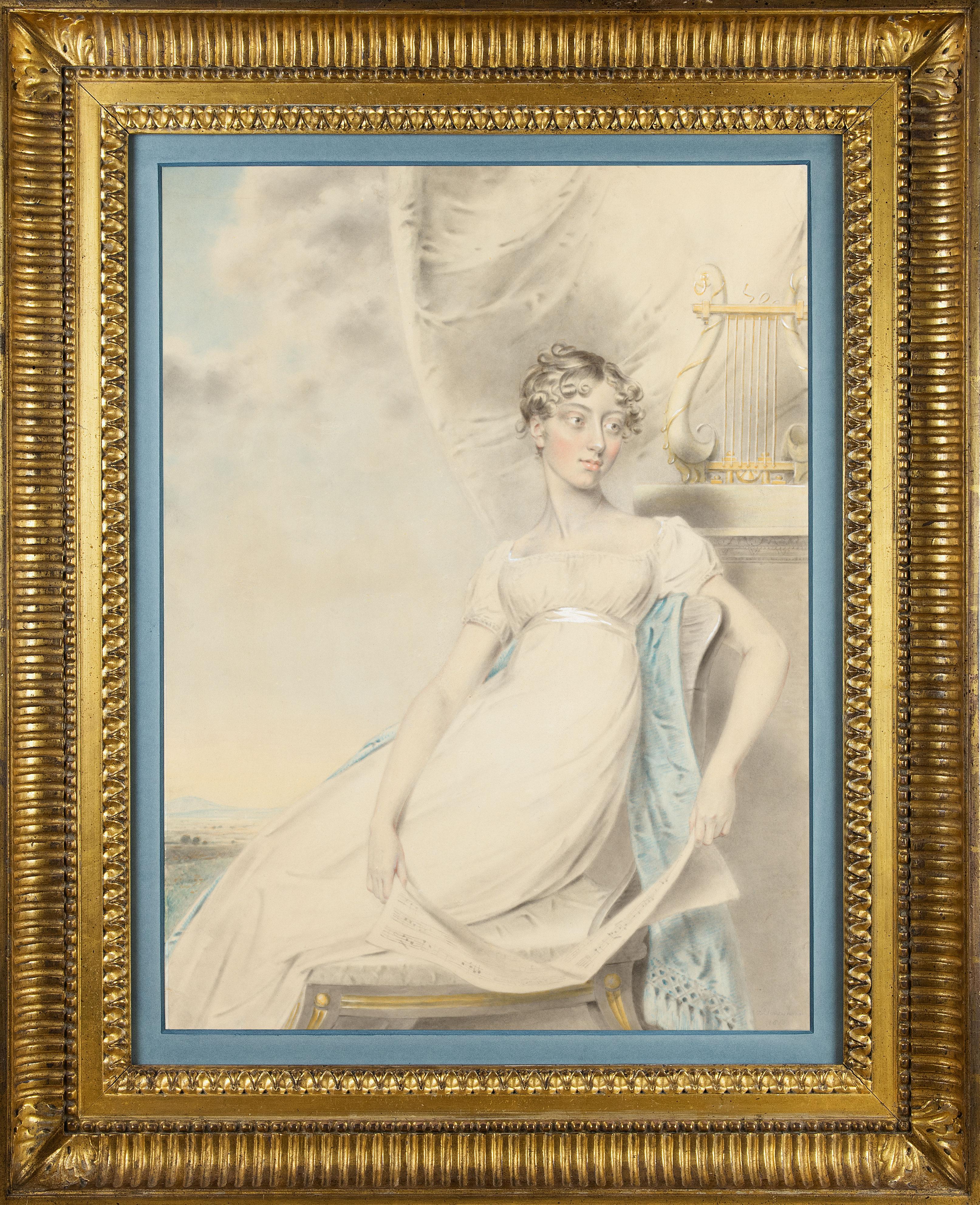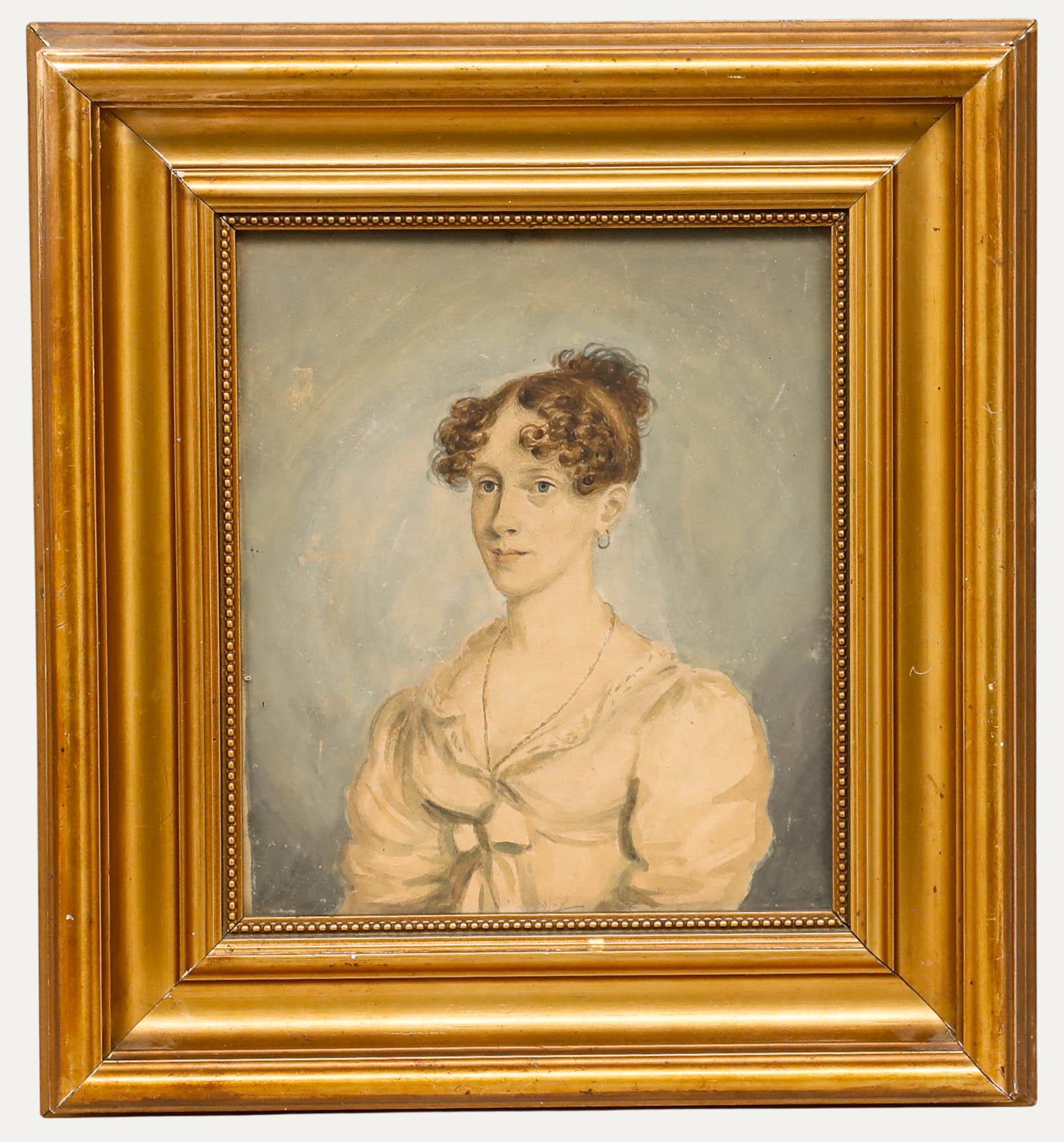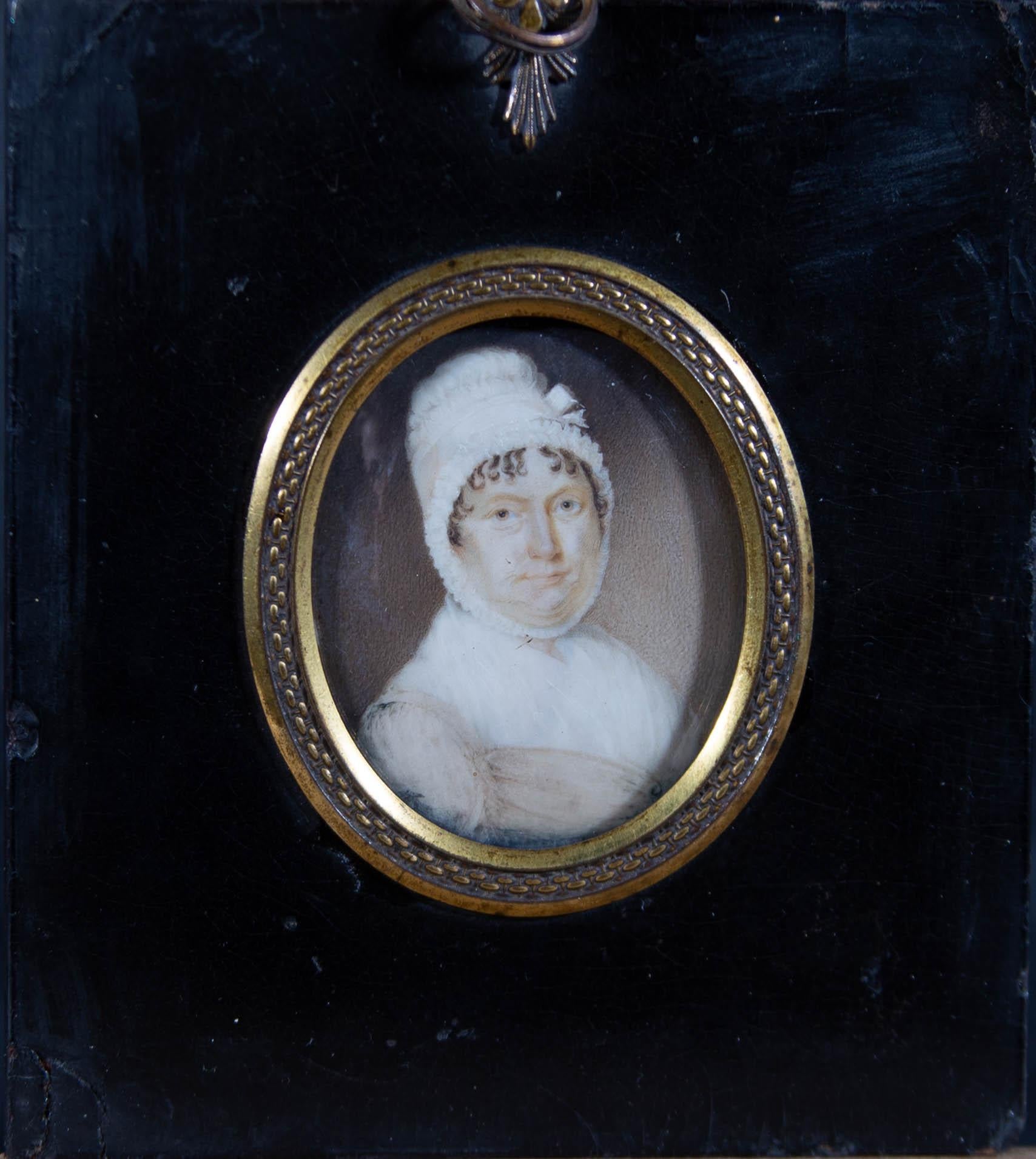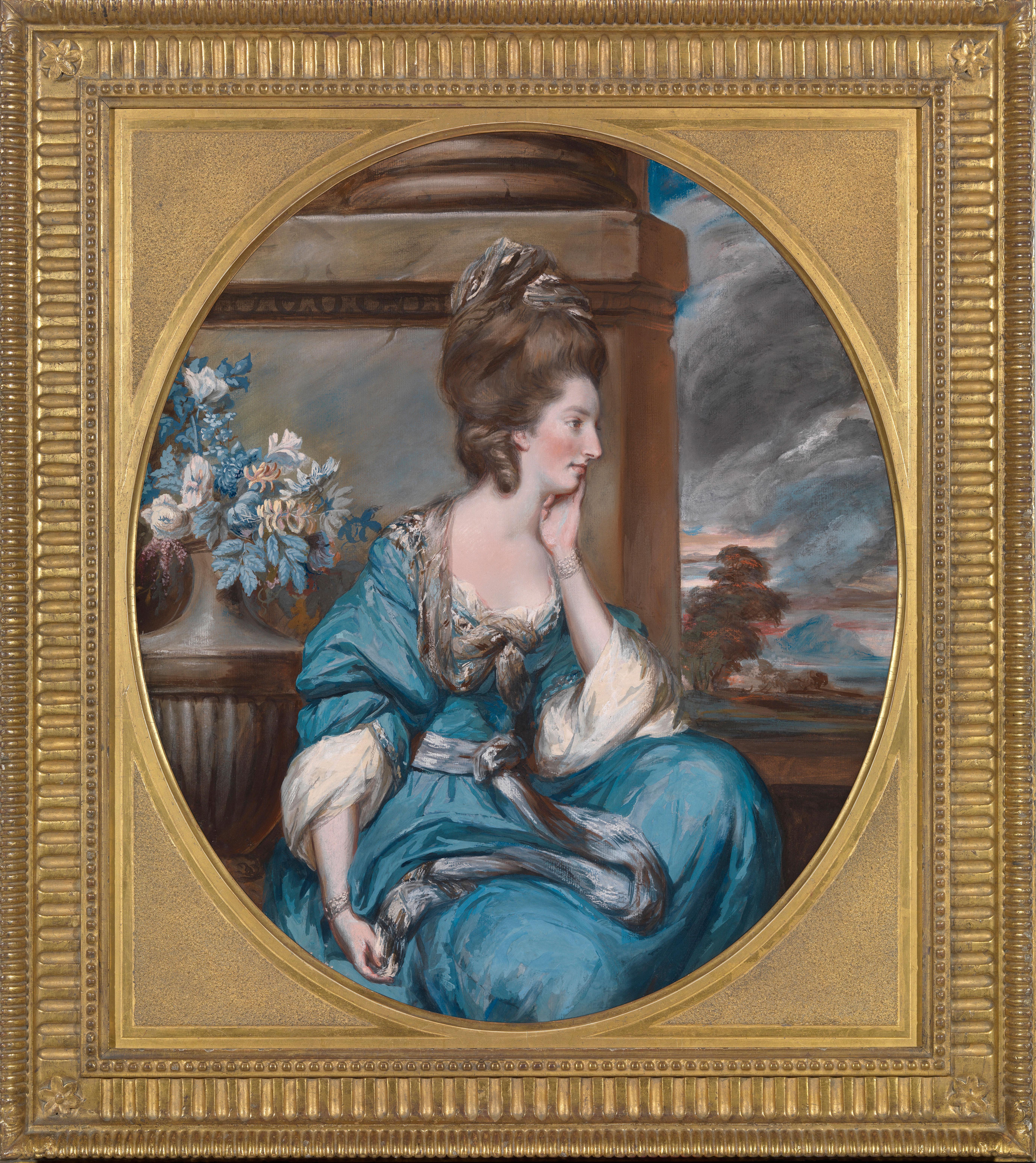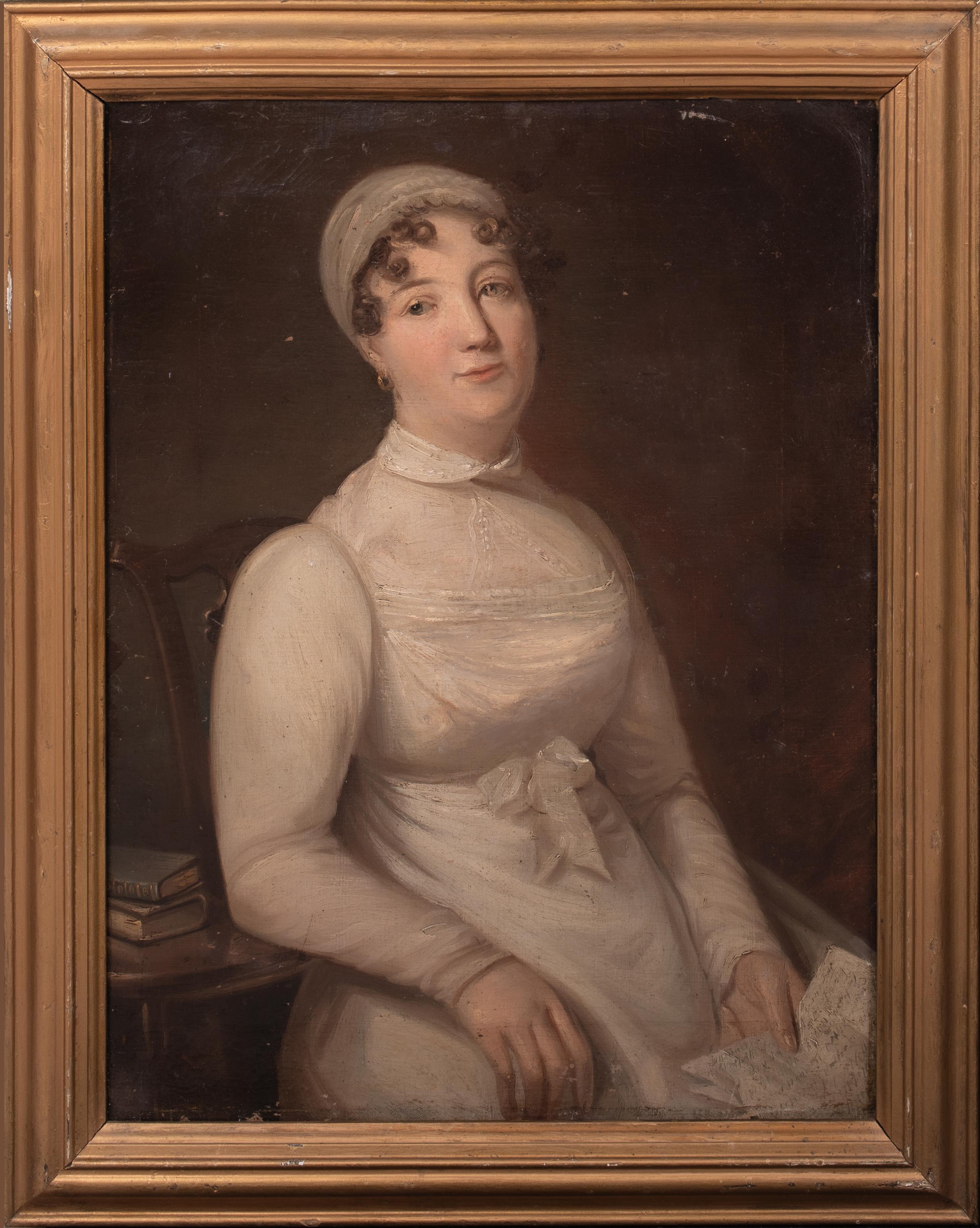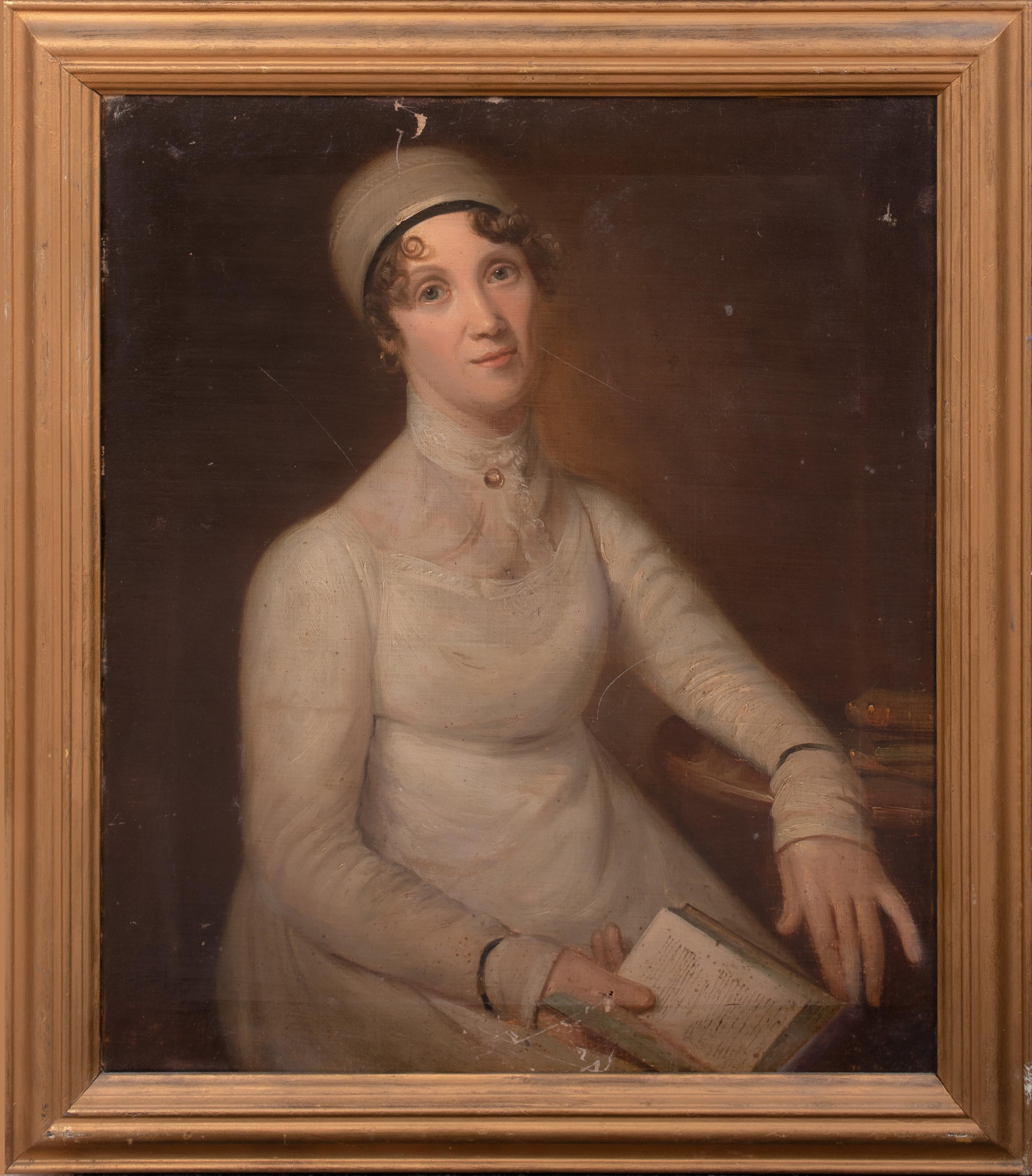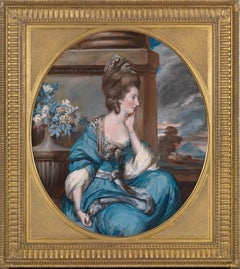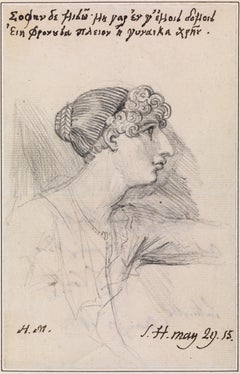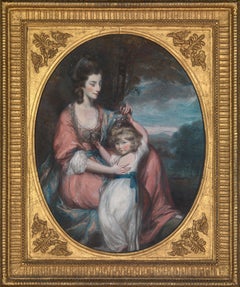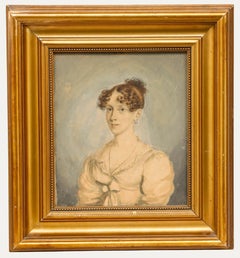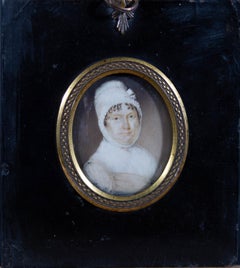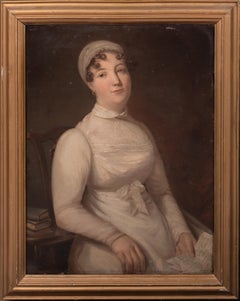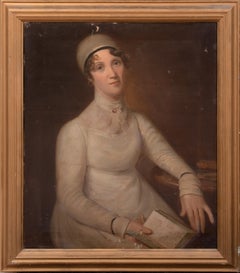Items Similar to Regency portrait drawing of Arabella Graham-Clarke
Want more images or videos?
Request additional images or videos from the seller
1 of 4
John DownmanRegency portrait drawing of Arabella Graham-ClarkeCirca 1810
Circa 1810
$9,369.34
£6,800
€8,047.18
CA$12,908.69
A$14,382.10
CHF 7,508.14
MX$174,617.91
NOK 94,372.41
SEK 89,204.85
DKK 60,071.27
About the Item
Collections:
The sitter, and by descent;
Christie's, 19th March 1928, lot 6;
Private collection to 2019
Literature:
G.C. Williamson, John Downman, A.R.A., his Life and Works, London, 1907, p. lv, no. 17.
Pencil, stump and watercolour
Framed dimensions: 18.50 x 15.63 inches
This characterful portrait by John Downman depicts Arabella Graham-Clarke, the maternal grandmother of the poet Elizabeth Barrett Browning. John Downman was born in Ruabon, North Wales, in 1750 and moved to London to become an artist in 1769, training with Benjamin West and enrolling as one of the first students at the newly formed Royal Academy Schools. After a Grand Tour to Italy, where he travelled with Joseph Wright of Derby, Downman returned to London in 1776 and established a practice as a portraitist: first in Cambridge, then in London and the West Country. Within a few years of his return to London in 1779, he gained a reputation as one of the most fashionable portraitists of the day, and was patronised by the royal family, as well as such fashion icons as the Duchess of Devonshire, the Duchess of Richmond, and Mrs Siddons. His popularity was largely dependent on his ability to work quickly and in quantity. In order to do so he gave up portraits in oil and devised a technique of working in chalks on a lightweight wove paper. This fine portrait depicts Arabella, daughter of Roger Altham, a Proctor in Doctor’s Commons, London. She married John Graham (later Graham-Clarke) in 1780 and lived at Fenham Hall, County Durham. Graham-Clarke was a considerable plantation owner, their son was compensated for several plantations in Jamaica.
- Creator:John Downman (1750 - 1824, British)
- Creation Year:Circa 1810
- Dimensions:Height: 11.75 in (29.85 cm)Width: 9.38 in (23.83 cm)
- Medium:
- Movement & Style:
- Period:
- Condition:Preserved in excellent condition, housed in a fine carved and gilt frame.
- Gallery Location:London, GB
- Reference Number:1stDibs: LU150727721192
About the Seller
5.0
Recognized Seller
These prestigious sellers are industry leaders and represent the highest echelon for item quality and design.
1stDibs seller since 2021
5 sales on 1stDibs
- ShippingRetrieving quote...Shipping from: London, United Kingdom
- Return Policy
Authenticity Guarantee
In the unlikely event there’s an issue with an item’s authenticity, contact us within 1 year for a full refund. DetailsMoney-Back Guarantee
If your item is not as described, is damaged in transit, or does not arrive, contact us within 7 days for a full refund. Details24-Hour Cancellation
You have a 24-hour grace period in which to reconsider your purchase, with no questions asked.Vetted Professional Sellers
Our world-class sellers must adhere to strict standards for service and quality, maintaining the integrity of our listings.Price-Match Guarantee
If you find that a seller listed the same item for a lower price elsewhere, we’ll match it.Trusted Global Delivery
Our best-in-class carrier network provides specialized shipping options worldwide, including custom delivery.More From This Seller
View AllRegency portrait drawing of Lady Nugent
By John Downman
Located in London, GB
Collections:
With Ellis Smith, London;
Private collection, to 2015.
Literature:
G.C. Williamson, John Downman A.R.A., his Life and Works,
p. lviii no...
Category
19th Century Old Masters Portrait Drawings and Watercolors
Materials
Pencil, Watercolor
Portraits of the Hon. Mary Shuttleworth and Anna Maria, 9th Baroness Forrester
By Daniel Gardner
Located in London, GB
THE HON. MARY SHUTTLEWORTH, NÉE COCKBURN (D. 1777)
and her sister
ANNA MARIA, 9TH BARONESS FORRESTER (D. 1808)
Pastel and gouache on paper laid on canvas, on their original backb...
Category
18th Century Old Masters Portrait Drawings and Watercolors
Materials
Pastel, Gouache
Portrait drawing of Harriot Mellon, Mrs Thomas Coutts
By Henry Fuseli
Located in London, GB
Inscribed by the artist in pen and brown ink, upper margin: 'σοφὴν δὲ μισῶ: μὴ γὰρ ἔν γ' ἐμοῖς δόμοις / εἴη φρονοῦσα πλείον' ἢ γυναῖκα χρή [Euripides, Hippolytus, 11, 640-41: “But a ...
Category
19th Century Old Masters Portrait Drawings and Watercolors
Materials
Pencil
18th century pastel portrait of Lady Augusta Corbett and her son, Stuart
By Daniel Gardner
Located in London, GB
Collections:
Commissioned by Andrew Corbett, husband of the sitter;
The Venerable Stuart Corbett;
Sir Stuart Corbett;
By descent to 2002;
Sotheby’s, London 21 March 2002, lot.104;
Lowell Libson...
Category
18th Century Old Masters Portrait Drawings and Watercolors
Materials
Pastel, Gouache
18th century portrait of the Royal Academy model George White
By John Russell
Located in London, GB
Collections:
Russell sale, Christie’s, 14 February, 1807: ‘John Russell, Esq., R.A. deceased, crayon painter to His Majesty, the Prince of Wales, and Duke of York; and brought from his late Dwelling in Newman Street’, lot 92, ‘St Peter’, bt. Thompson (£1.13s);
Anonymous sale; Sotheby's, London, 25th September 1980, lot 113;
Private collection, UK, 2016.
Literature:
Martin Postle, 'Patriarchs, prophets and paviours: Reynolds's images of old age', The Burlington Magazine, vol. cxxx, no. 1027, October 1988, pp. 739-40, fig. 9;
Martin Postle, Sir Joshua Reynolds: The Subject Pictures, Cambridge, 1995, p.136, repr.;
Neil Jeffares, Dictionary of pastellists before 1800, online edition, J.64.2928.
Signed and dated: J Russell/ fecit 1772 (lower right)
Framed dimensions: 25 x 31 inches
John Russell was admitted to the Royal Academy in March 1770, at the same time as Daniel Gardner. The nascent Academy Schools were still establishing their teaching structures, but central to the syllabus were the twin components of drawing after the antique and from life models. By 1772 Russell had already been awarded a silver medal and progressed to the life academy, where he produced this remarkable pastel study of George White. White was the most famous model employed by the Royal Academy and prominent artists in the second half of the eighteenth century. A paviour – or street mender –by profession White had been discovered by Joshua Reynolds, who in turn introduced him to the Academy. Russell’s striking head study demonstrates his abilities as a portraitist and pastellist, at the same time showing his interest in the Academy’s preoccupation with promoting history painting.
George White was one of the most celebrated models in eighteenth-century London. According to the painter Joseph Moser:
'Old George…owed the ease in which he passed his latter days, in a great measure to Sir Joshua Reynolds, who found him exerting himself in the laborious employment of thumping down stones in the street; and observing not only the grand and majestic traits of his countenance, but the dignity of his muscular figure, took him out of a situation to which his strength was by no means equal, clothed, fed, and had him, first as a model in his own painting room, then introduced him as a subject for the students of the Royal Academy.'
As Martin Postle has pointed out, whilst characterful studies of old men posed as biblical figures, prophets or saints by Continental old masters were readily available on the art market – Reynolds himself had copied a head of Joab by Federico Bencovich in the collection of his friend and patron, Lord Palmerston - finding a model in Britain from whom to execute a painting was more difficult.
White therefore offered a rare opportunity for artists to combine portraiture and history painting, by painting a model in the guise of an historical or literary character. In 1771 Reynolds showed at the Royal Academy a picture of White entitled Resignation. It was engraved in 1772 and accompanied by a stanza from Oliver Goldsmith’s Deserted Village, implying a literary context to what is essentially a portrait. In his annotated Royal Academy catalogue, Horace Walpole noted: ‘This was an old beggar, who had so fine a head that Sir Joshua chose him for the father in his picture from Dante, and painted him several times, as did others in imitation of Reynolds. There were even cameos and busts of him.’ White sat to, amongst others Johan Zoffany, John Sanders, Nathaniel Hone and the sculptor John Bacon...
Category
18th Century Old Masters Portrait Drawings and Watercolors
Materials
Pastel
Drawing of a captive woman
By Henry Fuseli
Located in London, GB
Collections:
Sir Thomas Lawrence, who acquired the contents of Fuseli’s studio;
Susan, Countess of Guilford, née Coutts (1771-1837), acquired from the Lawrence estate;
Susan, Baroness North (1797-1884), daughter of the above;
Mrs A. M. Jaffé, acquired in France, c. 1950 to 2016.
Black chalks, on buff-coloured paper
Stamped verso: ‘Baroness Norths Collection / of Drawings by H Fuseli Esq.’
Framed dimensions: 26.38 x 20.63 inches
This boldly drawn sheet depicting a seated figure was made by Fuseli at an important and highly productive moment in his career. The monumental drawing is closely related to another sheet by Fuseli in the British Museum which Schiff published as subject unknown. Both drawings were made when Fuseli was designing his most important sequence of historical works, including scenes from Shakespeare and Milton, The Nightmare and The Death of Dido which was exhibited at the Royal Academy to great critical acclaim in 1781. The present drawing does not relate directly to any of Fuseli’s finished historical paintings of the period, but evidently the image of a slightly menacing, seated and covered old woman was precisely the sort of motif he was playing with. It is notable that the same figure reappears later in Fuseli’s work as the witch from Ben Jonson’s Witch’s Song which Fuseli produced as both a painting and engraving in 1812.
Fuseli returned to London in 1779 from a highly creative and productive period in Rome and established himself as one of the leading history painters of the period. Fuseli re-established contact with his old mentor Sir Joshua Reynolds, becoming a regular guest at his dinner table and visitor to his studio. The earliest and most striking manifestation of this strategy was Fuseli's Death of Dido, exhibited in 1781 at the Royal Academy. Executed on the same scale as Reynolds's version (Royal Collection), Fuseli's vertically oriented picture was hung directly opposite Reynolds's with its horizontal orientation, inevitably inviting comparison between the two works and garnering Fuseli much publicity and favourable reviews in the newspapers.
The present, previously unpublished sheet, relates closely to a drawing now in the British Museum. That sheet shows the same seated old woman, drawn on a smaller scale and more schematic in design, seated next to an anatomical drawing of a man. The pose of this figure is related to the pose of Dido in his Death of Dido; the foreshortened torso, arrangement of head, oblique view of Dido’s features and arms all suggest that the study can be viewed as an initial thought for the composition. Fuseli may have initially thought of including the figure of the hunched and covered old woman. Drawn on identical paper to the British Museum sheet, our study is an enlarged depiction of the same figure, more elaborately delineated and developed. The presence of a chain to the right of the figure, suggests that the iconography was related in some way to a scene of imprisonment.
Fuseli had first explored the motif of the hooded old woman in an early Roman drawing, 'The Venus Seller'. The idea of a grotesque old woman, hooded and with angular nose and projecting chin seen in profile was most spectacularly used by Fuseli in his sequence of paintings depicting The Three Witches from Macbeth. Fuseli seems to have kept the present sheet and may have returned to it when preparing a painting of The Witch and the Mandrake from Ben Jonson’s Witch’s Song from his Masque of Queens in 1812. Here the same seated figure looks out from under her hood and picks a mandrake by moonlight. Jonson’s drama had been performed at the court of James I in 1609, inspired the subject. To throw the nobility of the queens into relief, the poet added a coven of witches, one of whom declares: ‘I last night lay all alone, On the ground, to hear the mandrake groan; And plucked him up, though he grew full low, And, as I had done, the cock did crow.’ The figure was reversed in the associated etching which was published in 1812. It seems likely that the present drawing remained as part of Fuseli’s working archive of figure studies.
The present drawing was presumably purchased with the bulk of Fuseli’s drawings after the artist’s death by Sir Thomas Lawrence. Lawrence’s large group of Fuseli drawings were then acquired by Susan, Countess of Guildford (1771-1837). Lady Guildford was the eldest daughter of the banker Thomas Coutts (1735-1822), who himself had supported Fuseli’s journey to Rome in the 1770s and had remained one of the artist’s key...
Category
18th Century Old Masters Figurative Drawings and Watercolors
Materials
Chalk
You May Also Like
Early 19th Century Watercolour - Regency Woman
Located in Corsham, GB
A charming depiction of a Regency woman dressed in white. The artist uses a delicate hand to capture the fine details of her features and clothing. Unsigned. Illegibly inscribed vers...
Category
Early 19th Century Portrait Drawings and Watercolors
Materials
Watercolor
Early 19th Century Watercolour - Portrait Of Mrs Powell
Located in Corsham, GB
A beautifully executed, Regency era portrait of an older woman in a lace mob cap. She is sporting the tight curls around her face, typical of this...
Category
19th Century Portrait Drawings and Watercolors
Materials
Watercolor
$508 Sale Price
20% Off
Portrait of Anna Maria Porter, early 19th Century attributed to THOMAS BARBER
By Thomas Barber
Located in Blackwater, GB
Portrait of Anna Maria Porter, early 19th Century
attributed to THOMAS BARBER (1768-1843)
Early 19th century portrait of Anna Maria Porter, oil on canvas attributed to Thomas Porte...
Category
Early 19th Century Portrait Paintings
Materials
Canvas, Oil
$2,094 Sale Price
20% Off
Portrait of Jane Porter, early 19th Century attributed to THOMAS BARBER
By Thomas Barber
Located in Blackwater, GB
Portrait of Jane Porter, early 19th Century
attributed to THOMAS BARBER (1768-1843)
Early 19th century portrait of Jane Porter, oil on canvas attributed to Thomas Barber. Excellent...
Category
Early 19th Century Portrait Paintings
Materials
Canvas, Oil
$2,094 Sale Price
20% Off
After John Downman - 1794 Watercolour, Sarah Siddons (née. Kemble)
By John Downman
Located in Corsham, GB
This accomplished watercolours is a fine copy of John Downman's portrait of Sarah Siddons. Painted in the early 19th century, watercolours was a contempo...
Category
18th Century Portrait Drawings and Watercolors
Materials
Watercolor
$315 Sale Price
20% Off
British School, 'Portrait of a Young Lady'
Located in Reepham, GB
A half-length portrait of a young lady, her costume à la Turque and wearing a double strand of large and lustrous pearls. She is deep in somewhat pensive thought, her right hand resting lightly against her chin, her left hand gently clasping the neck of a pottery flask...
Category
Early 20th Century European Late Victorian Paintings
Materials
Canvas, Giltwood, Paint
More Ways To Browse
Old Master Italian Drawings
Old Master Drawings Framed
Elizabeth Olds
Old Master Pencil Drawing
Portrait Duchess
Regency Portrait Of
Regency Oil Painting
Plantation Painting
Barrett Oil Painting
Grand Tour Watercolour
Benjamin C Brown
G Wright Art
Regency Oil Portrait
R John Wright
Joseph Wright Of Derby
Graham Clarke
Nature Photography
Illustrator Art
